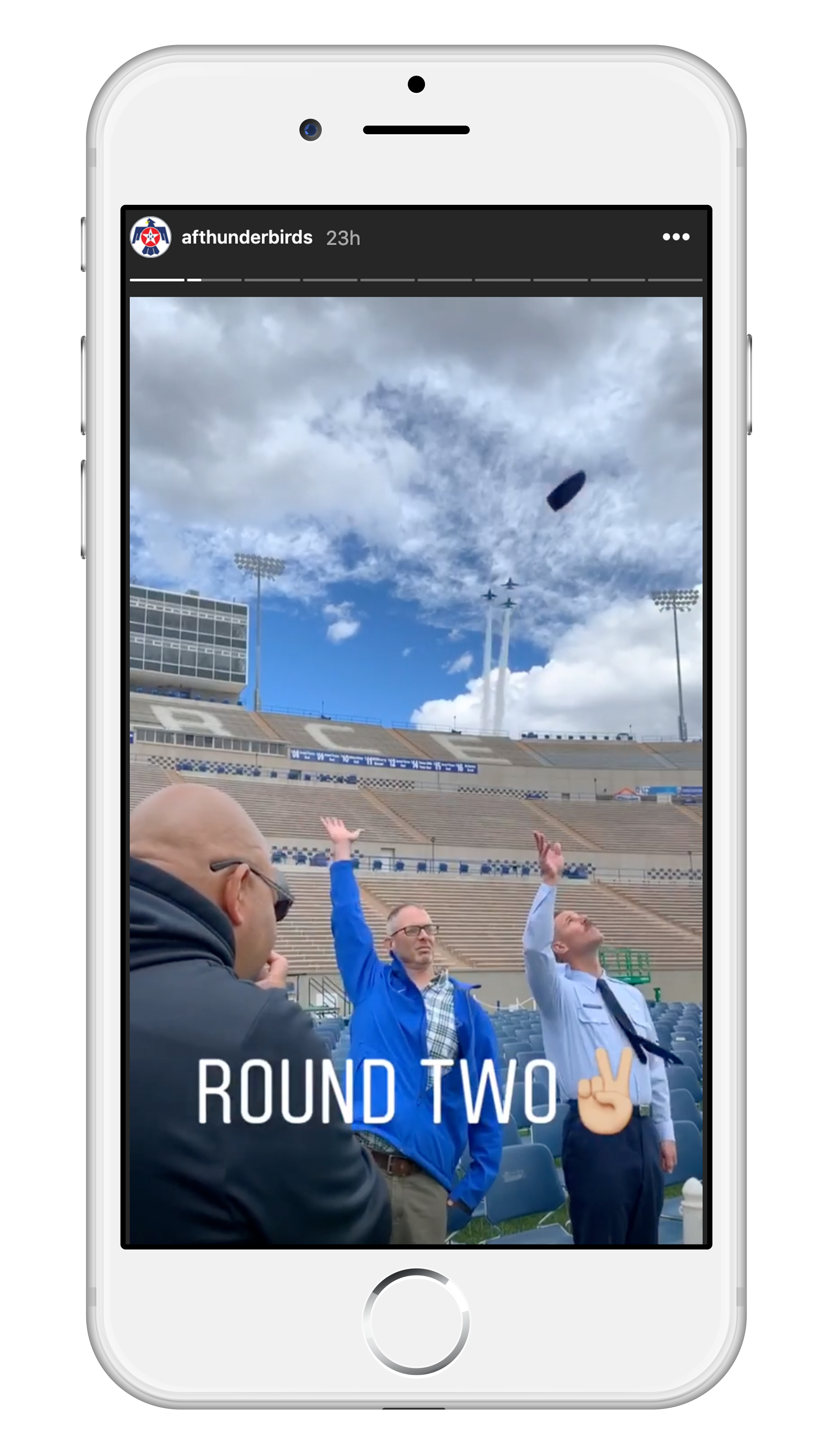The importance of online video content is increasing at an exponential rate, which means it is more important than ever to ensure that your air show business stays on top of the latest trends and incorporates video as an essential marketing tool.
With video being reported as the most popular and memorable form of online content, especially among Millennials, more and more brands are focusing their communication efforts through online video. Across all industries, the significant growth in demand for online video content has shifted branding strategies and placed a heavier focus on utilizing video to drive marketing results.
Through video, brands can capture their target consumer’s attention online and have a better chance of spurring conversions — desired actions by consumers, such as making a purchase. In a statistic from its 2018 Video Marketing Survey, Brightcove, Inc. found that 76 percent of consumers reported that they purchased a product or service after viewing a video. Among Millennials, that figure was 85 percent. For marketers, this return on investment is worth the increased advertising spending on online videos, with 51 percent of marketers naming video as having the best return per marketing dollar spent. Companies promoting their products and services have demonstrated — with their checkbooks — their confidence in video as a marketing tool; 2019 global video ad spending of $34.8 billion is up 39 percent from $25 billion in 2017 and forecasted to increase to $52 billion by the end of 2023 (Statista, 2019).
So, how can the air show industry take advantage of this? Fortunately, air show videos are some of the most exciting, compelling and engaging video content on social media. However, simply posting really cool videos of planes flying won’t sell air show tickets on their own. To truly benefit from the growing importance of online video and successfully utilize it to sell air show tickets, professionals will need to be aware of new technologies and practices. Here are a few of them.

- Take advantage and stay abreast of the latest video technologies and trends.
Video technology and online platforms are constantly changing and — if you don’t pay close attention — you can easily miss the next big thing. By taking advantage of the latest video technologies and jumping on new and emerging video practices, you will significantly increase the chances of users engaging with your content and ultimately making a purchase.
Today, the hottest trends in video include augmented reality interactive 360° video, live streaming, virtual reality and social media stories. Many air shows and performers have already experienced significant success with these technologies as they continue to boost the overall size of their social media audience. But these technologies will soon be outdated in favor of newer video trends that will emerge in the coming years, and professionals will need to be ahead of the curve. A big shift on the horizon is the increased focus on “mobile-first” video. All available data suggests that an increasing percentage of video will be watched by people on their mobile devices during the next few years. Marketers are recognizing this trend and forecasting that global video ad spending on mobile platforms will surpass that of traditional desktops by the year 2023.
- Do not let “excellent” be the enemy of “good.”
When it comes to social media video, it is often better to get quick and good video content out there rather than spend too much time trying to achieve a cinematic masterpiece. In many cases, it is critical that online video content is released on social media in a timely fashion to ensure the content is still relevant to viewers and will receive the best natural engagement.
This is not to say that the videos you post to social media should not be high quality. All the videos you post and promote on social media should be of a quality that will reflect positively on your organization’s brand and spur increased interest from social media users. However, if the difference between a “good” video and an “excellent” video is a substantial delay for development, oftentimes it is better to simply work with “good.”
- Tell a story.
Videos that tell a story are more compelling to audiences and, as a result, more engaging. Stories invoke personal connections and emotions that can influence purchasing behavior and drive more conversions for your business. Although the occasional compilation reel of planes flying does result in increased social media engagement from your audience, videos that tell a story and convey a message to the viewer tend to do better in generating revenue.
If you are an event organizer trying to promote your air show as a great source of family entertainment, create a video that tells that story. Make sure that it features a lot of footage of young families spending a day at your air show. Include footage of them watching the planes perform, buying concessions and walking around the event area. Use tight head shots of adults and children that make it clear they’re having fun.
Similarly, if you are trying to promote your air show to those of the Millennial demographic, feature video of Millennials attending the show. Edit together video of them watching the performers, drinking beer in a beer tent, socializing with their group of friends, playing games and snapping selfies. Particularly when it comes to Millennials, telling an interesting story about your air show and featuring their peers is essential to piquing their interest.
Overall, the stories you tell through video should be relatable to your desired target audience to boost the likelihood of engagements and conversions.
- Learn an editing software.
With video taking center stage, it is now more important than ever that you know how to edit video for your marketing purposes. To many, editing can be a daunting task … but it does not have to be. Fortunately, there are many editing programs out there for all levels of experience and types of users.
If you are an emerging video editor, Apple’s iMovie is a great choice to get started with. iMovie is a free application, available on Apple computers, and features a simple, user-friendly interface. It can process up to 4k video resolution and provides a trove of trailer templates, audio tools and video themes to simplify and expedite the editing process. However, iMovie does not have as many advanced capabilities as premium editing programs. Among some of the notable drawbacks to using iMovie include the inability to edit 360° video and customize the interface to fit your needs.
For the intermediate and advanced editors who are looking to create more intricate or complex videos, Final Cut Pro X or Adobe Premiere are your best bets. Although Adobe Premiere is considered by many filmmakers to be the top of the line in editing software, Final Cut Pro X offers pretty much the same capabilities except in a much smoother interface and at a more attractive price point. Final Cut is only available for Apple computers and can be purchased for a one-time fee of $299.99. With Final Cut Pro X, you can add as many different video and audio tracks to your video as desired, customize your workspace to fit your needs and edit all professional video formats – such as 360° and high-resolution 4k video.
Learning how to use one of these or some other video-editing software will take the mystery out of video production and improve your ability to create compelling video productions quickly, frequently and inexpensively.

- Target and promote your videos on Facebook and Instagram.
One of the most intuitive and accessible online advertising tools for air show professionals continues to be the Facebook Ad Center. In advertising through Facebook, you have the ability to promote your videos across both Facebook and Instagram to increase the opportunity for sales.
Before you try to boost your online video across Facebook, it will behoove you to become familiar with some idiosyncrasies and characteristics of posting video on Facebook that will positively impact the reach and effectiveness of your video ad.
First, keep the text featured in your video post to an absolute minimum. If Facebook deems a boosted video post to contain too much text, it will limit the potential reach of your video ad and, ultimately, cause you to spend more of your ad budget to reach less people.
Second, keep your video short and capture the audience’s attention early. Statistics tell us that videos that get off to a slow start or go on too long tend to lose viewers, so it is vital that you feature your video’s most attention-grabbing elements at the beginning. And it is just as important to edit your video with the viewers’ very short attention span as your first consideration.
Third, with the growing popularity of mobile-first video, you can increase the success of your video by making it vertically oriented or in a square frame to be more mobile friendly. Additionally, when it comes to mobile video ads, the Facebook Ad Center recommends that you keep your video length to 15 seconds or less so that people are more likely to watch until the end.
Once you have your video uploaded to Facebook, you then need to be able to accurately define and target the specific social media audience with the Facebook Ad Center. Facebook allows you to promote your video ads to users based on their location, demographics and interests. As you adjust the specific targeting parameters for your video, Facebook does a great job of showcasing the potential reach of your video and whether your audience is well defined or not.
- Location: When targeting based on location, enter the city, town or airport where your air show event is taking place and designate a radius of not more than 60 miles around that location. ICAS spectator statistics tell us that more than three-quarters of your spectators will come from within 60 miles of your show site; two-thirds come from within 40 miles.
- Demographics: When targeting based on demographics, consider your organization’s goals first. For example, if you seek to dramatically increase the number of Millennials who attend your show, you might decide to rely on traditional marketing to attract other age groups and target viewers between ages of 21 and 38 for your video-based social media ads.
- Interests: Facebook and its sophisticated algorithms give you the ability to target your audience based on what pages and topics they follow across Facebook. By focusing on an audience interested in aviation, air shows and outdoor events, you are more likely to make contact with the type of individuals who are already predisposed to be interested in your video and, ultimately, buy a ticket to attend your show.
- Other factors: The final elements to successfully promoting your video across Facebook and Instagram will be selecting your budget, deciding on the amount of time your ad will be active, and adding a button to link users to your air show’s ticketing site. Based on your decisions about those details and the marketplace in which you will be advertising your video, Facebook’s Ad Center algorithms will provide live estimates to your video’s potential reach.
So, here are the key takeaways: Online video is continuing to grow in popularity and as an effective marketing tool. Make sure that your videos take advantage of the latest technologies and trends, tell a compelling story that will resonate with your audience, and are produced to maximize their chances of being successful when promoted on social media. And with online video marketing forecasted to grow at exponential rates, the time for you to learn how to edit videos and promote them strategically across social media is now.









Great article, Chris! Very timely and useful.
Thanks Greg! Appreciate the feedback.
Comments are closed.